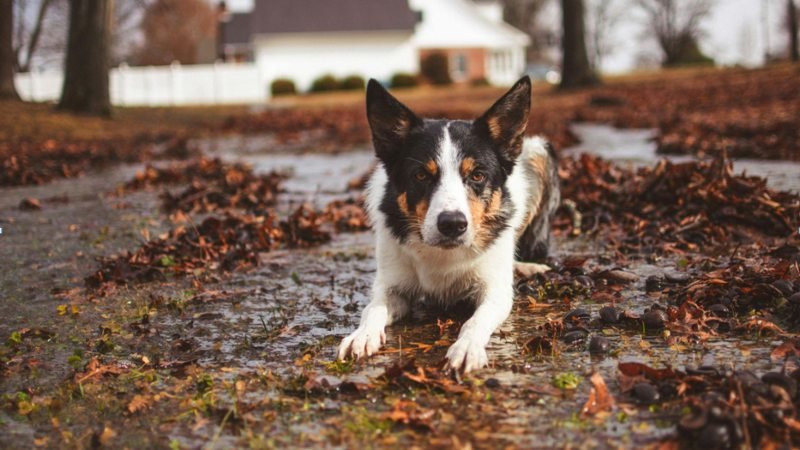Dogs harbor an uncanny knack for unearthing mud, and though witnessing your canine frolic in the mire can evoke both amusement and exasperation, this behavior sprouts from their innate instincts. Many owners puzzle over why their clean-loving companion gravitates toward a muddy patch. The reasons range from instinctual drives bequeathed by their wild ancestors to the sheer delight of mud clinging to their fur. Comprehending the motives behind this messy behavior can empower owners to manage it with enhanced patience.
Ancestral Instincts
Dogs descend from wild forebears like wolves, and despite domestication, they preserve many of the instincts that once propelled their predecessors to survive. Rolling in mud may echo those enduring behaviors.
Masking Scent
In the wild, animals harness scent to communicate, track prey, or delineate territory. Wolves and other predators sometimes wallow in potent-smelling substances like mud, carrion, or manure to shroud their own scent. By draping themselves in external odors, they lessen their chances of detection by potential prey. This instinctual behavior might illuminate why your dog revels in rolling in mud—it may still harbor an ancient drive to cloak its scent.
Camouflage
Beyond scent masking, wild animals sometimes employ mud to meld into their surroundings. Camouflage aids them in eluding predators or stalking prey. Although your domesticated dog doesn’t need to hide from predators, this instinct may persist, spurring them to roll in mud as a natural behavior inherited from their wild ancestors.
Cooling Off and Comfort
Not all mud-rolling behaviors stem from ancestral instincts. Some dogs pursue mud for more practical reasons, such as cooling off or soothing discomfort.
Temperature Regulation
Mud functions as a natural coolant. On a scorching day, your dog may immerse itself in mud to reduce its body temperature. The wet, cool texture of mud can deliver instant relief from heat, especially if your dog sports thick fur. Dogs don’t sweat like humans; they rely on panting and their paws to dissipate heat. A muddy patch transforms into an enticing spot for an overheated dog to cool down and feel more comfortable.
Relief from Irritation
Dogs with allergies or skin irritations may also gravitate toward mud because it soothes their skin. Mud can operate as a natural anti-inflammatory agent, temporarily easing discomfort caused by itching, bug bites, or other irritants. The cool, wet texture of mud can calm a dog with irritated skin, granting relief they might not find elsewhere.
Simply for Fun

Beyond instinct and comfort, a simple truth persists: some dogs just love getting dirty. Rolling in mud can be an enjoyable activity for them, akin to chasing a ball or cavorting in a stream.
Playful Behaviour
For many dogs, rolling in the mud is pure delight. They savor the sensation of the soft, squishy texture under their paws and on their fur. Much like romping in the grass or burrowing in the dirt, rolling in mud furnishes an outlet for their playful energy. This behavior often surfaces in young dogs or high-energy breeds like French Bulldogs that crave ample physical stimulation.
Sensory Exploration
Dogs perceive the world through their noses and bodies. Every texture, smell, and surface unveils a new sensory experience. Mud, with its distinct smell and feel, furnishes a unique and satisfying sensory input. Rolling in mud permits dogs to explore new textures while engaging their natural curiosity about their environment. For them, it’s a form of play and exploration that quenches their need to investigate the world around them.
How to Handle Your Dog Rolling in Mud
While understanding why dogs enjoy rolling in the mud is important, that doesn’t mean you want to grapple with the mess every time you take your dog outside. There are ways to manage and even diminish this behavior, as well as tips for cleaning up after your dog inevitably discovers the mud.
Prevention Tips
One way to prevent your dog from rolling in mud is to supervise them during walks, especially in areas where mud abounds. Distraction can also work—if you spot your dog eyeing a muddy patch, redirect their attention with a toy or treat. Offering an alternative activity, like running or playing with a ball, can help expend their energy and steer their focus away from the mud.
Additionally, consider walking your dog in areas where mud is scarce, such as on paved paths or well-maintained grass. Keeping your dog on a leash during particularly muddy seasons can also help regulate where they explore.
Cleaning Up
If your dog succeeds in rolling in mud, cleaning them promptly is key to preventing further mess. Start by using a hose or a bucket of water to rinse off the mud while it’s still wet. If the mud has dried, brushing it out of their fur before bathing them can streamline the cleanup process.
Use a gentle, dog-safe shampoo to wash your dog thoroughly, concentrating on areas where mud clings to their fur. Rinse well to ensure no residue lingers, which could cause skin irritation. Dry them with a towel and, if needed, employ a blow dryer on a low setting to fully dry their coat.
Conclusion
Dogs roll in mud for many reasons, whether it’s an instinctual drive to mask their scent, a practical method of cooling off, or simply the joy of playing in something squishy. While it can frustrate owners to handle the aftermath of a mud-rolling session, understanding the reasons behind the behavior can help you manage it with patience and care. By implementing preventive measures and mastering effective cleanup strategies, you can keep your dog safe and happy while still allowing them to indulge their natural instincts occasionally.
Did you find this article helpful? If so, check out the rest of our site for more informative content in Kaz Magazine.
